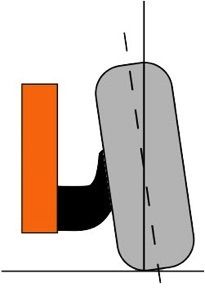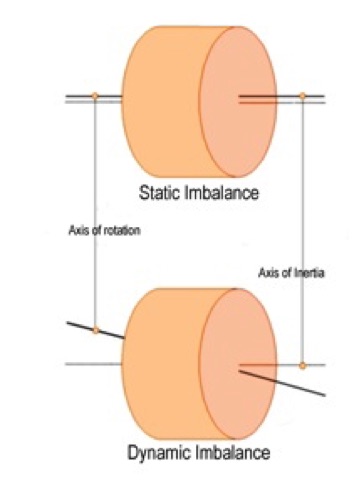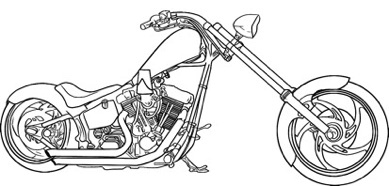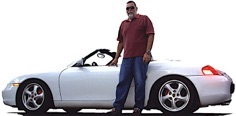


Published in the November 2010 issue of “Die Porsche Kassette
“I get a shimmy at speed”, or “my car pulls to the left when cruising down the road” are two of the most common complaints regarding steering wheel feedback ...
... and the question generally following is: “Should I have an alignment done, or do I need balancing?”
I will attempt to oversimplify what otherwise are complex and very precise adjustments, very important for your Porsche to perform at its best.
Balance
The technical definition of balance is: the uniform distribution of mass about an axis of rotation, where the center of gravity is in the same location as the center of rotation.
Because of manufacturing imperfections and/or additional requirements such as the tire’s valve stem, the tire pressure monitoring system, etc., when a tire is mounted on it’s wheel the combined weight distribution is not perfect. This can be corrected by the addition of small weights strategically attached to the edge or underside of the wheel. Tire balance actually encompasses balancing the tire and the wheel to which it is mounted on. Tire balancing is a necessity because an imbalance of mass will cause the wheel to wobble when the tire rotates, generating vertical or lateral vibrations which may increase with speed and which can be felt through the steering wheel.
The best way to balance tires is by dynamic balance, where tires are mounted on a rotating axle which has sensors capable of detecting small unbalanced forces on the axle. These sensors are connected to a computer which calculates the forces and taking into account the diameter and width of the tire, tells the operator how much counter weight to add and exactly where to add it on the wheel to eliminate the imbalance.
There are actually several types of imbalance that can occur:
Static Imbalance: The vertical movement resulting from light or heavy wear spots on a tire.
Dynamic Imbalance: Side-to-side movement resulting from unequal weigh on the sides of the tire and/or wheel.
Run-out Imbalance: Excessive movement generally due to improper bead seating of the tire on the wheel.
Vehicle Imbalance: Vibration due to vehicle components other than tire/wheel assembly, such as brake rotor, wheel hubs and drive lines.
Static and dynamic imbalance can be corrected with a dynamic (spin) balancer. Run-out can be corrected by properly re-mounting the tire and vehicle imbalance can be corrected by replacing or repairing the imbalanced component.
After some miles on a new set of tires, imbalance can occur due to the loss of a counterweight or by wear spots on the tire. If you start to feel a slight vibration through the steering wheel, have your tires’ balance checked.
Alignment
The adjustment of the angles of the wheels so that they are set to the manufacturer’s specifications.
Alignment is much more complex than balancing since it involves primary and secondary wheel angles, which are obtained by adjusting several suspension parts.
The three basic alignment parameters are: Toe, Camber and Caster, but an alignment goes well beyond just these three since there are secondary angles that can be adjusted, such as SAI, Included Angle, Toe-On-Turns, Maximum Turns, Toe Curve, Track Width Difference, Wheel Base Difference, Frame Angle, Ride Height, etc.
Toe: is the symmetric angle that each wheel makes with the longitudinal angle of the vehicle. In other words, when the steering wheel is straight, are the tires pointing in (toe in) or out (toe out)?
In a rear wheel drive car, such as a Porsche, increased front toe in provides for better straight line stability, but hampers turning response and increases tire wear.
So, for DE (high speed, straight-line stability) you need a different setting than for an AX where turning response is favored over straight line stability.

Camber: is the angle between the vertical axis of the wheels and the vertical axis of the car, when viewed from the front or the rear. Generally Porsches have negative camber, especially on the rear wheels, which means that the inner top edges of the wheels are closer than the inner bottom edges.
Generally, more negative camber improves grip when cornering but induces more tire wear on the inner edges of the tires but, on the other hand for maximum straight line acceleration, the greatest traction will be attained with a zero camber angle.
Caster: is the angular variation from the vertical axis of the suspension. Think of the rake in a chopper’s front suspension.
Caster has more to do with the ability of the driven tires to self-center themselves (straight-line stability).


Most of these adjustments interact with each other. Changing camber will affect toe, and changing ride height will alters the geometry and requires additional modifications to bring back the alignment to spec.
All of our cars come from the factory precisely aligned, but alignment is not permanent.
Bumps, pot holes, curbs and general wear will affect the alignment settings which need to be brought back to spec periodically.
With a proper alignment (as close to the factory specs as possible), you will be able to reduce excessive tire wear, have good cornering traction, and maintain high speed stability in your Porsche.
For additional information on tire balancing and wheel alignment, please visit our website at: www.PedrosGarage.com.
Happy Porsche’ing,
© 2010 Technolab/PedrosGarage.com


